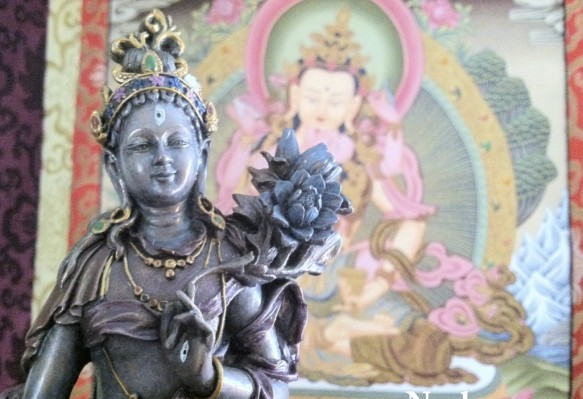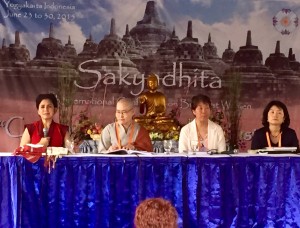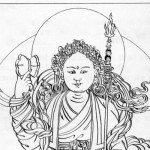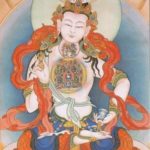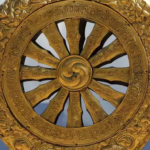Sakyadhita: Remembering the Yoginis
Without the great Buddhist leaders of the past, the tradition would not have survived. Women and men who have devoted their lives to study and practice of Buddhism have allowed a living lineage from the time of the Buddha to be carried on until today. That community has been composed of not only of monks and nuns but also of yogis, yoginis, scholars, meditators, oracles, dynastics, healers and many other leaders who fall outside the lay/monastic divide that is often applied to Buddhism.
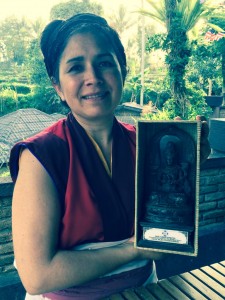
Here is a photo of me after my presentation at the Sakyadhita International Conference on
Buddhist Women. We were gifted these beautiful Prajnaparamita statues after the presentation. My topic called for developing awareness of female religious leader in Tibetan history. In particular, I called for a new way of speaking about the Buddhist clergy (the sangha) that is inclusive of the full scope of Tibetan Buddhist religious roles. This is a summary of that presentation in response to requests for a posting about my talk at the conference.
Some Background
This presentation was a response highlighting the diversity of women’s roles in Tibetan Buddhist narrative history, to point out that they cannot be accurately categorized as “monastic or lay.” That is a term generally used to describe two different kinds of Buddhists, but this is biased towards particular types of Buddhism such as Theravada and Mahayana and excludes major Buddhist leaders of Vajrayana Buddhism.
Part of the trouble is ambiguous translating. During translations, many times scholars and other people use the word “lay” to describe ordained, vow carrying, life long practitioners who are highly trained religious specialists. But this is a mistranslation of terms for yogis (ngakpas; Tib. sngags pa) or a host of other terms (see below). In the dictionary, the english word “lay” refers to non-trained religious specialists who are not of the clergy. So when Tibetan Buddhism is spoken of as “lay and monastic” this is done by overlooking an additional third category, the ordained clergy of Tibetan Buddhist tantra, which in this context, I refer to as yogis and yoginis.
What are tibetan terms for “lay” people? This is an important question and creating a mini-dictionary of those terms will be a fun project for another post. Perhaps a more accurate use of the term “lay” could correspond to the tibetan term, genyen, (dge bsnyen), which refers to a lay follower, a Buddhist practitioner who is not a religious cleric or religious specialist, is not trained or ordained, but instead is a member of the congregation.
Why does this matter?
It may be a relief for serious Buddhists who do not feel “called” to be nuns/monks to learn that in Tibetan Buddhism, that there has been more than one form of serious practice besides celibacy. I often refer to them as Buddhist yogis, which refers to a rendering of up to a dozen terms for contemplative Vajrayana practitioners, which I will describe below.
The Third Kind of Buddhist
I used a study of three biographical collections, Nyoshul Khenpo’s Marvelous Garland of Rare Gems, Dudjom Rinpoche’s Nyingma School of Tibetan Buddhism and the Garland of White Lotuses, a tibetan language collection of female biographies, to draw examples and statistics to illustrate that when saying “monastic or lay” people, that this could exclude seventy percent of the female Buddhist religious leaders we have recorded in Tibetan Buddhist history. The bulk of my presentation was spent showing data from historical Tibetan Buddhist female figures to illustrate the range of roles they played. This featured a discussion of the different terms that are used in Tibetan language from historical narratives to describe the variety of religious roles that women played in Tibet. Here are some of those terms below.
Terminology for
Non-Celibate, Non-Monastic Buddhist Women
in Tibetan Narrative Literature
སྔགས་མ་
“Ngakma” is a phonetic rendering of the Tibetan word: sngags ma “yogini or mantrin” སྔགས་མ་ It sounds something like “nak ma” or even “nak pa” This is term can refer to non-celibate Buddhist clergy, to vow holding female practitioners of Vajrayana, to highly realized female yoginis, and to ritual specialists. Sometimes they are regarded only as ritual specialists or magicians, however historically they were also philosophers, contemplatives, religious leaders, doctors and more. For example, Togden Sakya Sri, a Dzogchen teacher.In many instances these yogis, the ngakpas are ordained and take life long vows. See Van Schaik for a description of the role of the tantric clerics during the period after the decline of the Tibetan empire.
རྣལ་འབྱོར་མ་
“Naljorma” is a phonetic rendering of the Tibetan word: rnal byor ma, “yogini” རྣལ་འབྱོར་མ་ It sounds like: “naljorma.” This term can refer to females practicing internal yoga practices and meditation, it can refer to highly accomplished female meditators, it can also refer to highly accomplished female practitioner associated with Vajrayogini, Dorje Phagmo.
མཁའ་འགྲོ་
“Khandro” is a phonetic rendering of the Tibetan word: mkha’ ‘gro, “dakini” མཁའ་འགྲོ་
It sounds like: “khandro.” This term can refer to an highly accomplished female practitioner, a highly realized woman, a female lama or it also could refer to the consort of a Lama.
སྒོམ་ཆེན་མ་
“Gomchenma” is a phonetic rendering of the Tibetan word: sgom chen, “meditator” སྒོམ་ཆེན་མ་ It sounds like: “Gom chen ma.” This term can refer to a highly accomplished practitioner who focuses on meditation practices and inner yogas, often in years of isolated practice in solitary intensive retreat.
གཅོད་པ་
“Cho pa” is a phonetic rendering of the Tibetan word: scod pa, “severance practitioner” གཅོད་པ་ It sounds like: “cho pa.” This term can refer to practitioners of the tibetan meditation and ritual practice known as “chod” or severance practice. This is a funerary practice as well as a visionary ritual and contemplative practice focused on confronting fears with compassion, facing one’s death and visualizing the surrender of attachment to self.
རས་མ།
“Ray ma” is a phonetic rendering of the Tibetan word: ras ma, “cotton clad yogi” རས་མ། It sounds like: “ray ma.” This is the same word that is in the name of the famous yogi, “Milarepa,” the cotton clad yogi, referring to the white cotton cloth worn by practitioners of the six yogas. These cloths may be the only clothing worn by that practitioner or also during retreats focused on the six yogas, a white cloth may be worn.
རབ་བྱུང་མ་ཡིན་པ་
“Rab jung ma yin pa” is a phonetic rendering of the Tibetan word: rab byung ma yin pa, which means “didn’t go forth into homelessness; or “is not a monk/nun. ” རབ་བྱུང་མ་ཡིན་པ་ It sounds like: “Rab jung ma yin pa.” This is a modern term I have recently heard used by Khenpos from Larung Gar, in Tibet to describe the practitioners who are neither lay people, nor monastics.
སྤྲུལ་སྐུ།
“Tulku” is a phonetic rendering of the Tibetan word: sprul sku, “incarnation” སྤྲུལ་སྐུ། “Incarnate Lama.” Though most tulkus are males, some are also females. Sometimes these may be monks or nuns, sometimes non-celibate yogis or yoginis. See my previous article.
སྤྲུལ་བ།
“Tulwa” is a phonetic rendering of the Tibetan word: sprul ba, “emanation” སྤྲུལ་བ། “emanation.” These terms, tulku and tulwa, are often used interchangeably by english speaking Buddhists, but I have also heard numerous Lamas assert that they have different connotations.
འདས་ལོག་མ་།
“Delog” is a phonetic rendering of the Tibetan word: ‘das log ma, “returned from death” འདས་ལོག་མ་།It sounds like: “day log.” This refers to a kind of oracle in Tibetan Buddhism who journeys to the post-death state to retrieve messages from the dead and for the living. There are both male and female delogs.
This array of terms makes clear something that is often not apparent to people new to Tibetan Buddhism, that there are a diverse variety of kinds of Tibetan Buddhist practice and practitioners. To use the “lay vs monastic” category when describing the Buddhist clergy, these differences are made invisible.
It was not uncommon for the major teachers, the Lamas, of Tibetan Buddhism to marry or have consorts. Some may even dressed similarly to monks but practice as yogis and therefore be non-celibate, so unfortunately it is not always easy to discern by looking from the outside. The ambiguity and variety is further enhanced because even these titles I have listed are not always used in uniform ways, with variation from lineage to lineage and variation from one region or valley to another. Sometimes these roles and titles were occupied by monks or nuns or other times by non-celibate practitioners or by vow carrying ordained Tantric Buddhists.
It may seem confusing at first, however it communicates an important principle of Buddhism – that of diversity. It is not a mono-culture.
Traditionally, it’s said the Buddha gave 84,000 different
teachings to the 84,000 different kinds of beings.
Therefore although, the only way to begin to really get to know Buddhism is through direct experience and exploration of the lineage/s that we have access to. Meanwhile, we should also keep in mind that the Buddhist community carries many forms. See two posts on this topic: The variety of Buddhist robes; and the diversity of Buddhism.
Despite previous ambiguities of terms, all terms are being used with increasing specificity in english as Buddhism is translated into the global culture. Buddhists today can use inclusive language that reflects awareness of Buddhist diversity and the variety of ordained Buddhist clergy. Instead of repeating the “lay/monastic,” category for describing Buddhism, we can instead use these alternatives:
- monastic, yogic and lay people
- Buddhist clergy and lay people
- ordained sangha and lay people
- Buddhist leaders and lay people
This was the main thrust of my talk at the conference. I was delighted by the many dozens of people who approached me afterwards to express enthusiasm for hearing of lineages non-celibate Buddhist masters whose specialities were working with householders and lay people. Many of the Mahayana and Vajrayana nuns who came and approached me also expressed solidarity and enthusiasm, which was a great joy. For some of them it was like “preaching to the choir” since many of them had direct encounters with Nyingma and Kagyu yogic lineages. For others it was informative since they had no exposure. Even Venerable Karma Lekshe Tsomo expressed that she had for years spoken up about the importance of recognizing the varieties of Buddhist sangha.
That was the spirit of the conference – the most non-sectarian environment possible, everyone appreciating the gifts of each other’s lineages, with relaxation and joy about the differences. There was no religious fundamentalism or religious intolerance or talking down others or negative gossip. Instead there was so much respect and appreciation. It was an honor to be a part of such an environment. It showed me that when Buddhist women come together, they have the great potential to demonstrate what is possible for all Buddhists.
References:
(1) Dorjé, Nyoshul Khenpo Jamyang, and Sogyal Rinpoche. A Marvelous Garland of Rare Gems: Biographies of Masters of Awareness in the Dzogchen Lineage. Trans. Richard Barron. 1St Edition edition. Junction City, CA: Padma Publishing, 2005. Print.
(2) ‘phags bod kyi skyes chen ma dag gi rnam par thar ba pad+ma dkar po’i phreng ba. lha sa: bod ljongs bod yig dpe rnying dpe skrun khang, 2013. Vol.1, 1-73, 74-114.
(3) Rinpoche, Dudjom; Dorje, Gyurme. The Nyingma School of Tibetan Buddhism: Its Fundamentals and History. Wisdom Publications; 1991. Kindle Edition 18963.
(4) Schaik, Sam van. Tibet: A History. Yale University Press, 2013. Print.

